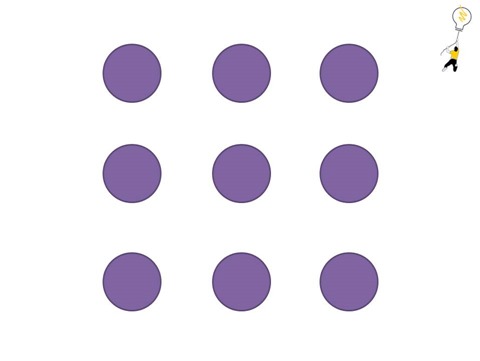Doing more of the same will get you more of the same – no change. Change happens from shifts in the effort, perspective & shared assumptions. At the same time, it is observant about the beneficial changes that emerge.
Working to understand the difference between First Order Change – Operating within the same pattern & Second Order Change – Operating through pattern-breaking, testing & retesting; lends itself to experiential team-building activity.
Nine Dots of Change
Guidelines:
- Connect the nine dots shown below by four straight lines without lifting the pen from the paper.
If you are unfamiliar with the challenge, try to solve it on paper before reading on.

What does this have to do with First order or Second order change?
First order change:
- Before knowing or seeing the solution, I kept thinking that the dots composed a square, a boundary. Thinking this, I kept trying different versions of drawing lines within the imposed boundary – doing more of the same faster while getting more frustrated. Leading me to believe this is some impossible feat.
- The failure was not in my effort or caring but in my attempted solution.
Second order change:
- The solution happens when I understand the self-imposed boundaries and I need to break, test, or experiment with the pattern.
- The solution arrives from examining the assumptions about the dots, NOT in reviewing them.
“… it obviously makes a difference whether we consider ourselves as pawns in a game whose rules we call reality or as players of the game who know that the rules are “real” only to the extent that we have created or accepted them, and that we can change them.” – Paul Watzlawick
This is great for dots – what about work & change & people?
I could not figure this out on my own … I had to go to the internet to find the solution. When I saw it, I thought, DUH!
This happens to you & me every day. We find ourselves in similar challenges. No matter how calmly, professionally, and logically we tried, we ran in circles faster, inward spiraling asphyxiating doom loops.
This assumption that the solution will occur by pushing harder only causes us to examine the dots (the people or situation), leading to the thought that “They (or I) must be broken” (or stupid or lazy or young or old, etc.).
The solution becomes clearer when the Second Order Change perspective is applied—changing the viewpoint & premise to a slightly different approach to the problem.
Pausing & examining your assumptions about the strategies, guidelines, & systems. For this slight change to occur, we need to be observant, ask questions, synthesize multiple views, find ideas for pattern-breaking, & accept that the dots (the people or situation) are a part of the whole / the team.

